Despite their comparatively short flowering period, Heuchera convince with their striking leaves. If you offer the purple bells a suitable location, they decorate gardens well into winter.
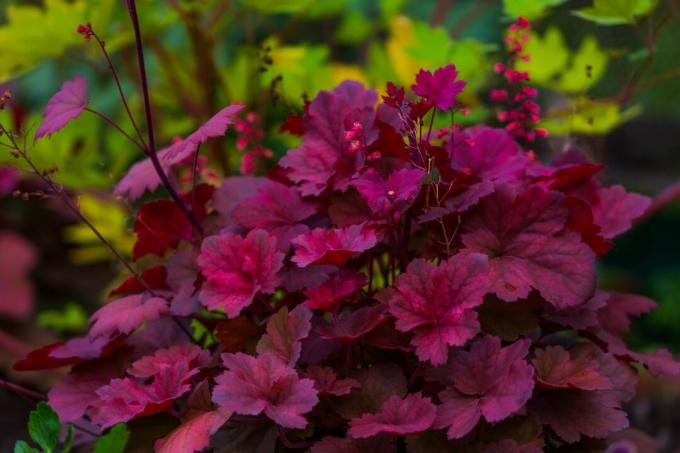
The purple bell is also known to hobby gardeners by its generic name Heuchera known. The leaf ornamental perennial is comparatively undemanding and versatile in the garden or in planters. You can now choose between numerous varieties of purple bells. A selection of the most beautiful HeucheraWe have collected species and their varieties. We also explain what the optimal locations look like and how you can ideally care for the purple bells.
contents
- Purple bells: flowering time, properties and origin
-
The most beautiful Heuchera varieties and species
- Heuchera micrantha
- Heuchera villosa
- Heuchera sanguinea
- Planting purple bells: location and procedure
-
The right care
- watering and fertilizing
- Cut purple bells
- Are purple bells hardy?
- multiply Heuchera
- Are purple bells poisonous?
Purple bells: flowering time, properties and origin
The genus Heuchera originally comes from the North American continent and is mainly found in crevices and forests near the coast. Heuchera belongs to the saxifrage family (Saxifragaceae) and contains around 50 different species, for example the small-flowered purple bell (Heuchera micrantha) and the Blood Crimson Bells (Heuchera sanguinea). You may also know the purple bell as the silver bell. The leaves resemble maple leaves and can vary in color and pattern depending on the variety. The leaf margins are serrated to lobed.
The flowering time of the purple bells, like their appearance, varies depending on the variety. Most Heuchera- Varieties bloom from May to July, with cultivated forms such as the shaggy silverbell (Heuchera villosa var. macrorhizza) only show their flowers in autumn. However, the purple bell does not owe its German name to its striking leaves, but to its bell-like inflorescences. The panicles of flowers rise up amidst the colorful leaves and reach a height of 40 to 100 cm, depending on the variety. The bloom of Heuchera can show different colors, from greenish white to pink and dark red.

The herbaceous purple bell is perennial and evergreen or wintergreen, adorns the garden all year round and shows a whole set of new leaves in spring. In addition, butterflies and bees also enjoy the purple bells.
The most beautiful Heuchera varieties and species
Heuchera offers an amazing variety of species and varieties. Making a decision is not easy - we show you a nice selection here.
Heuchera micrantha
This species appears rather inconspicuous in the natural form, but serves as an important parent species for various cultivars and hybrids. In June to July, the greenish-white to pink flowers rise up to 100 cm in panicles. Achieved without the inflorescences Heuchera micrantha a height of 40 cm. A humus-rich, fresh and loose soil in a sheltered, partially shaded location is preferred here. Overall, the species is robust and quite undemanding, provided the area is protected from waterlogging and deep frost. Ensure a planting distance of around 20 to 30 cm in small groups of 5 to a maximum of 10 plants per m².
- ‘Shanghai‘conspicuous by its dark, violet leaves. The beige to delicate violet flowers appear from May to August. This variety withstands -15 °C, although frost damage can occur in unprotected locations. 'Shanghai' enjoys a shaded to sunny location.

- 'Paris' intense pink flowers from June to July. The green-colored leaves have a silvery pattern, which forms a wonderful contrast to the intensely colored flowers. The soil should be fresh, well drained and rich in nutrients. Choose a sheltered part shade for this variety. Temperatures down to – 15 °C are not a problem.
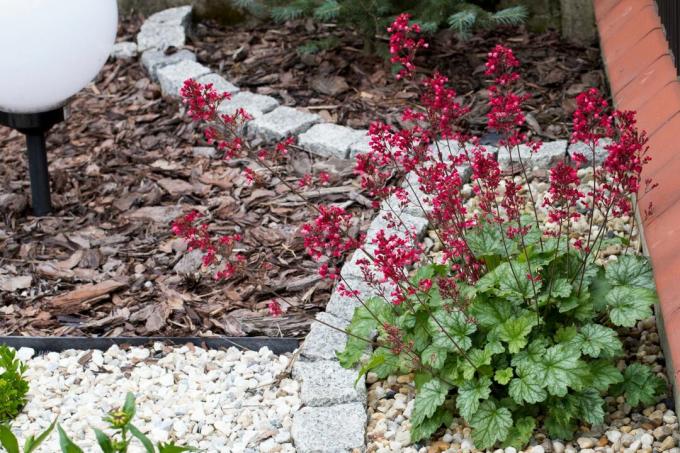
- 'obsidian' impresses with its black-red, silky shimmering splendor of leaves, which can grow up to 50 cm high. The snow-white flowers appear from July to August. With this variety, keep a larger planting distance of about 30 to 40 cm. 'Obsidian' withstands temperatures of – 22 °C without any problems.
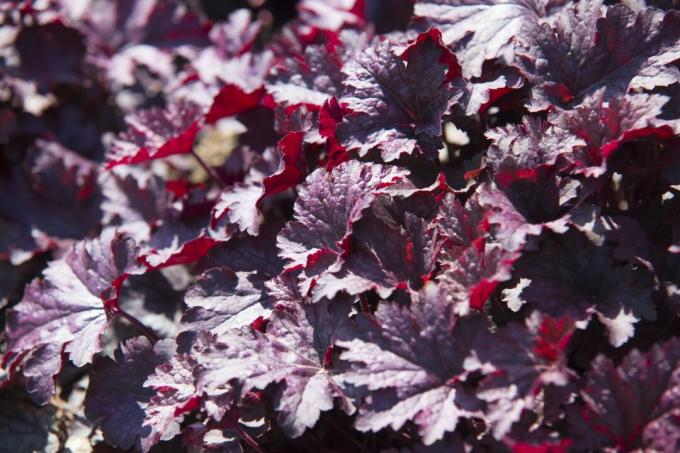
Heuchera villosa
the Heucheraspecies is also considered an important parent species of some popular cultivars. The wild form is characterized by strong green and particularly patterned leaves. When in bloom it reaches a height of 70 cm. As with others Heucheraspecies, long-lasting ground frosts damage the plant, as does waterlogging, whereby Heuchera villosa is one of the hardy species and can withstand temperatures down to – 15 °C.
- ‘Berry Smoothie‘fascinates by its purple, silvery leaves. The white flowers appear from June to July, although this variety is generally lazy. This variety is popular for its longevity and persistence. A planting distance of 20 to 30 cm offers 'Berry Smoothie' enough space.
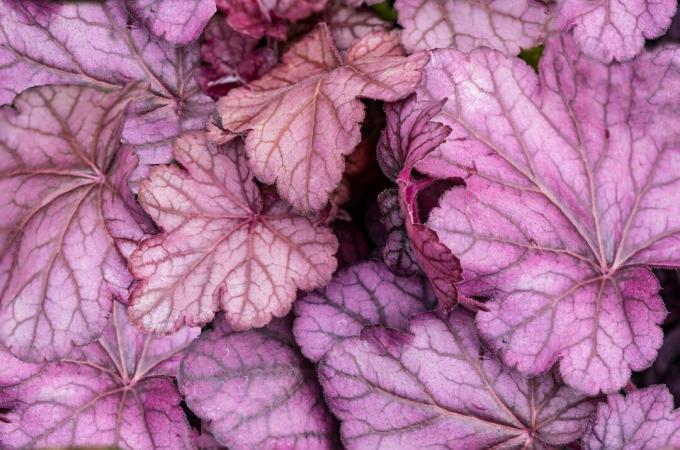
- ‘caramel' is also one of the flowering lazy ones Heucheravarieties, but this does not affect their ornamental value. The large, caramel-colored leaves with a dark underside shine intensely, especially in the midst of green-leaved neighbors. 'Caramel' flowers from June to August and has good heat tolerance. Plant this variety at a distance of 35 cm, i.e. about 8 specimens per m².
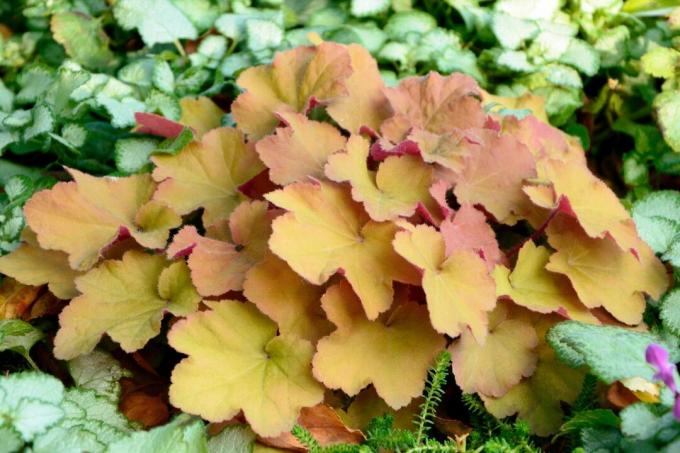
Heuchera sanguinea
in its wild form Heuchera sanguinea rather inconspicuous, but known by the variety 'firefly'. Overall, these species grow up to 40 cm high, and even up to 100 cm when in bloom. The original variant prefers to grow on coarse-grained, humus-rich limestone soil.
- 'firefly' belongs to the standard range with its crimson flowers. The variety flowers from June to July and tolerates a sunny to partially shaded location. Choose a maximum of 10 plants per m² to provide enough space. The same soil preferences apply – fresh, well-drained and nutrient-rich.

Tip: The popular ornamental shrub Heucherella, also known as foam bells, is a hybrid of Heuchera and Tiarella (foam bloom). The hybrids combine the beautiful leaves of the Heuchera and the attractive blossoms of the foam flower.
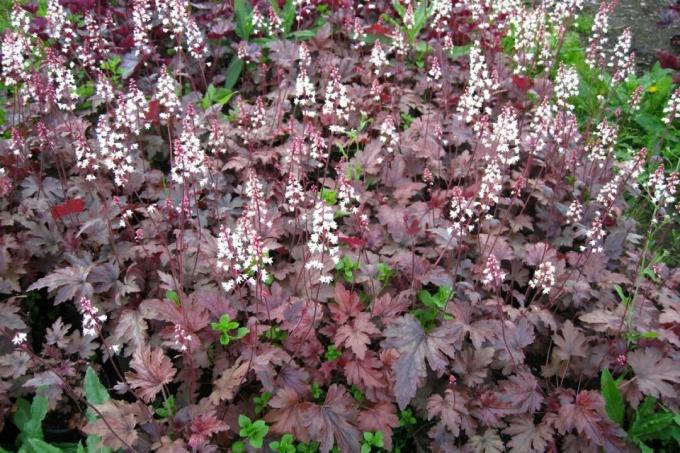
Planting purple bells: location and procedure
Select a species of Purplebell that suits your site - see species and cultivar descriptions above for species-specific site preferences. In general, choose a sunny to semi-shady place that offers protection from frost.
Tip: Use the leaf color as a guide – the darker the leaves, the sunnier the location should be. Otherwise these varieties may turn green. Conversely, species and varieties with light foliage should not be exposed to strong sunlight.
For most species and varieties, a permeable and loose soil and constant soil moisture are important. Drought is only tolerated for a short time - excessive soil moisture promotes diseases and pest infestations. rust fungi and vine weevil come at Heuchera-Species especially in locations that are too humid, snails completely ignore the purple bells.
Once you have found a suitable location, you can plant the purple bells almost all year round. The ground should not be frozen, which is why the months from March to October are ideal. In small groups of 3 to 10 plants and a planting distance of 30 to 45 cm, depending on the species and variety, the purple bell has enough space to grow. The soil is prepared by loosening it and removing weeds.
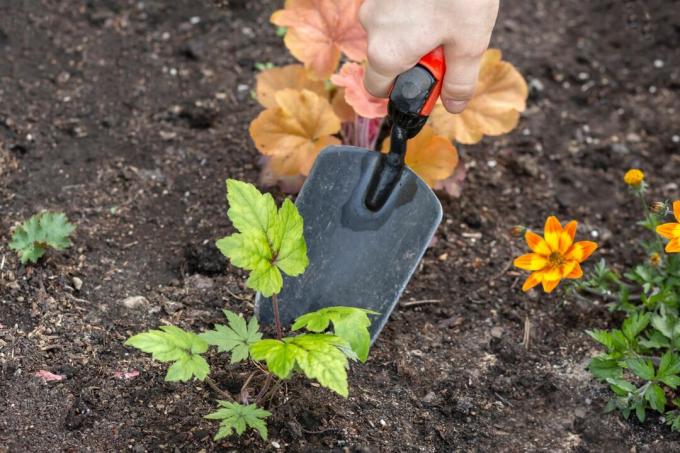
Most species of purple bells need nutrient-rich soil. In extremely sandy soils, a humus-rich soil should be added, otherwise fertilizing in the spring is sufficient. For example ours Plantura organic flower fertilizer could Heuchera supply the required nutrients. It has a long-term effect of at least 3 months. This means that fertilization in spring allows the purple bells to get through the year healthy. If your soil is very clayey and therefore prone to high soil moisture, mix in generously up to 50% sand to thin it out.
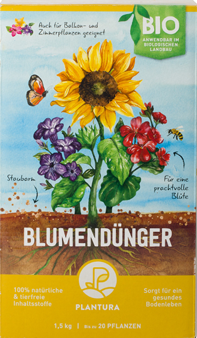
Plantura organic flower fertilizer
effective long-term effect,
good for the soil, harmless for humans, animals and nature
Use the rootstock as a basis for planting depth. The purple bells should be planted so deep that the rosette of leaves lies flat on the ground. After planting you may Heuchera pour generously.
Beautiful can be Heuchera- Present species in flower boxes or pots. The purple bells grow up to 30 to 40 cm in width. Accordingly, the pot should have a diameter of at least 30 cm. A water drainage hole and a drainage layer made of gravel or grit prevents waterlogging, which must be avoided at all costs. A humus-rich substrate such as ours is best Plantura organic potting soil. It is rich in nutrients and offers the necessary permeability due to the existing expanded clay. In addition, it consists of 100% natural raw materials, which means that CO2 can be saved. A drainage layer is recommended.
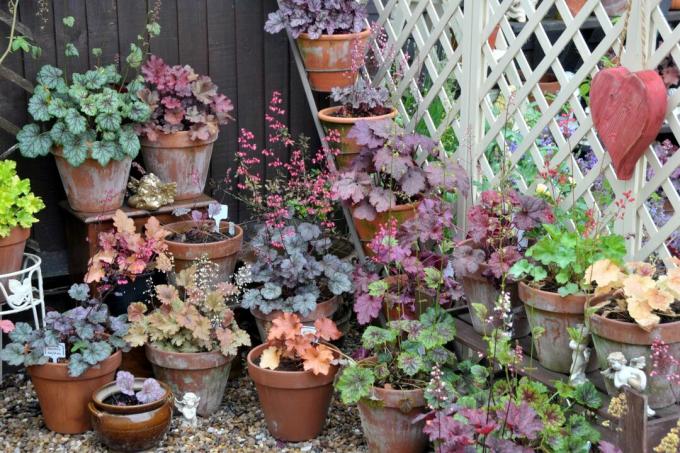
The right care
If the conditions for planting were met, the purple bell care is no longer time-consuming.
watering and fertilizing
Pour the purple bells with tact - the purple bells tolerate short dry periods better than constant moisture. In general, the soil should not be too wet, but should not be too dry either. In the bed, an annual fertilization of the purple bells with a primarily organic flower fertilizer or some fresh compost is possible. For best results, spread fertilizer in spring. Plants cultivated in pots should definitely be supported by a long-term fertilizer, but no more than once in spring and once in late summer.
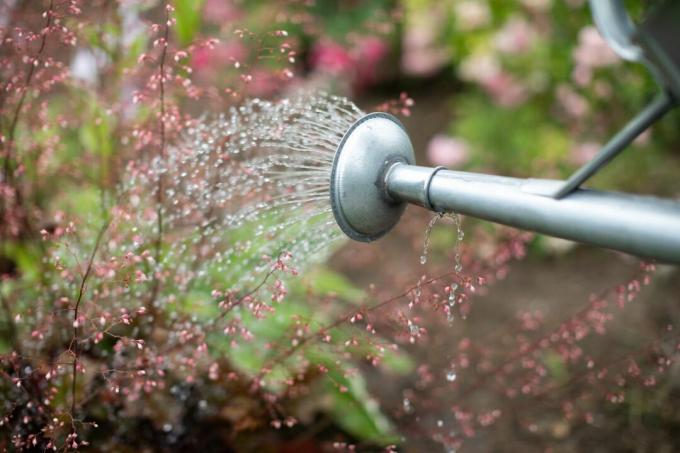
Cut purple bells
Regularly cutting out the withered leaves not only beautifies the appearance of the Heuchera, but leads to more strength for the remaining leaves. Cut the purple bells for maintenance in the spring. Make sure you cut about 10 cm high so as not to damage the lower part of the plant. Avoid cutting in autumn, as the foliage serves as winter protection and also decorates the garden attractively in winter.
More important than cutting the leaves is a division of the rootstock every 2 to 3 years. The purple bell forms underground rhizomes. These store nutrients, but are also used for vegetative propagation. Neighboring offshoots compete with the mother plant for light, water and nutrients, causing the entire bunch to lose vitality over time. As Heuchera share successfully, we will explain to you in the further course of the article.
Are purple bells hardy?
Purple bells are hardy provided they are planted in a sheltered spot. In suitable locations, they easily withstand temperatures of up to -22 °C. In order to provide your purple bells with enough nutrients for the coming spring and thus for their new shoots, you can use the Heuchera prepare for the winter with a leaf cover. Place the purple bells cultivated in the tub in a sheltered but not frost-free place, as they need a cold period to be able to sprout again in spring.
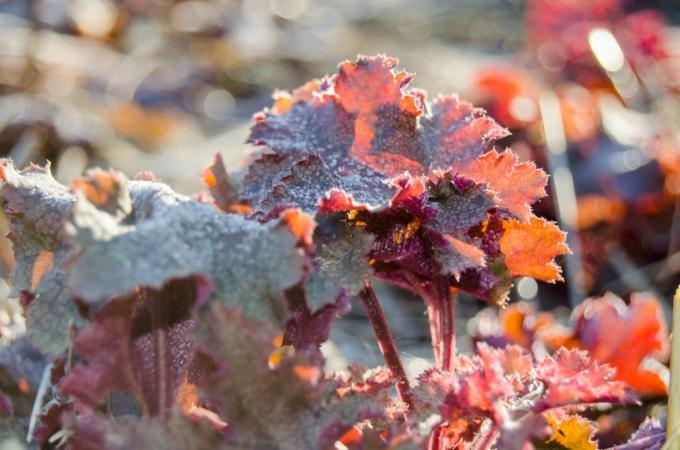
multiply Heuchera
The simplest and most common method Heuchera to multiply and to help it to grow again, takes place via the above-mentioned division. To do this, carefully dig up the plant and divide the rhizomes into sections, each with a terminal bud. This can be done with a simple pair of rose scissors. The newly won pieces can then be planted with sufficient planting distance. Water the newly planted rhizomes well and care for them as described.
Are purple bells poisonous?
The purple bell is not poisonous, neither for us humans nor for animals. You can use the colorful ones Heuchera plant them in the garden without worrying and enjoy their beauty.
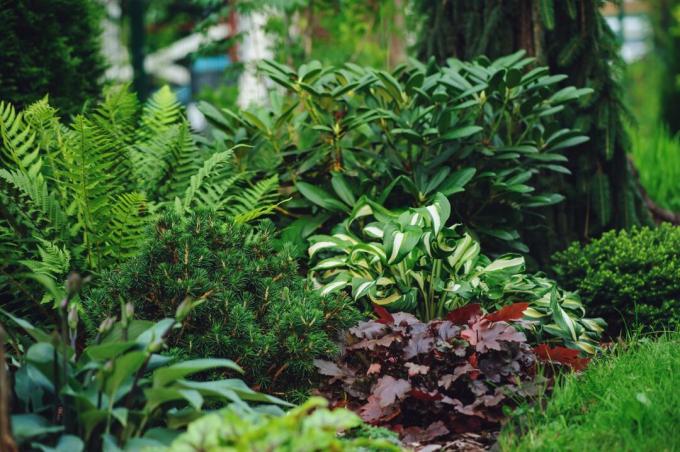
In the partially shaded garden, the purple bells can be wonderful hosts (hosta) combine. This genus also displays beautifully patterned leaves, elegant flowers and offers a wide range of different cultivars.
...and receive concentrated plant knowledge and inspiration directly in your e-mail inbox every Sunday!


